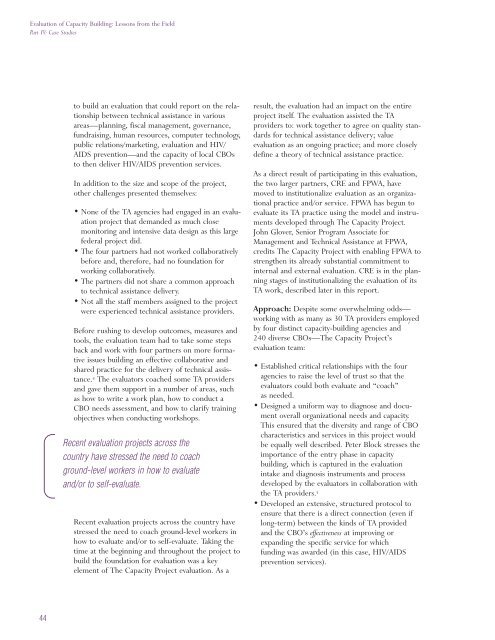Lessons from the Field - Seer Consulting
Lessons from the Field - Seer Consulting
Lessons from the Field - Seer Consulting
Create successful ePaper yourself
Turn your PDF publications into a flip-book with our unique Google optimized e-Paper software.
Evaluation of Capacity Building: <strong>Lessons</strong> <strong>from</strong> <strong>the</strong> <strong>Field</strong><br />
Part IV: Case Studies<br />
44<br />
to build an evaluation that could report on <strong>the</strong> relationship<br />
between technical assistance in various<br />
areas—planning, fiscal management, governance,<br />
fundraising, human resources, computer technology,<br />
public relations/marketing, evaluation and HIV/<br />
AIDS prevention—and <strong>the</strong> capacity of local CBOs<br />
to <strong>the</strong>n deliver HIV/AIDS prevention services.<br />
In addition to <strong>the</strong> size and scope of <strong>the</strong> project,<br />
o<strong>the</strong>r challenges presented <strong>the</strong>mselves:<br />
• None of <strong>the</strong> TA agencies had engaged in an evaluation<br />
project that demanded as much close<br />
monitoring and intensive data design as this large<br />
federal project did.<br />
• The four partners had not worked collaboratively<br />
before and, <strong>the</strong>refore, had no foundation for<br />
working collaboratively.<br />
• The partners did not share a common approach<br />
to technical assistance delivery.<br />
• Not all <strong>the</strong> staff members assigned to <strong>the</strong> project<br />
were experienced technical assistance providers.<br />
Before rushing to develop outcomes, measures and<br />
tools, <strong>the</strong> evaluation team had to take some steps<br />
back and work with four partners on more formative<br />
issues building an effective collaborative and<br />
shared practice for <strong>the</strong> delivery of technical assistance.<br />
4 The evaluators coached some TA providers<br />
and gave <strong>the</strong>m support in a number of areas, such<br />
as how to write a work plan, how to conduct a<br />
CBO needs assessment, and how to clarify training<br />
objectives when conducting workshops.<br />
Recent evaluation projects across <strong>the</strong><br />
country have stressed <strong>the</strong> need to coach<br />
ground-level workers in how to evaluate<br />
and/or to self-evaluate.<br />
Recent evaluation projects across <strong>the</strong> country have<br />
stressed <strong>the</strong> need to coach ground-level workers in<br />
how to evaluate and/or to self-evaluate. Taking <strong>the</strong><br />
time at <strong>the</strong> beginning and throughout <strong>the</strong> project to<br />
build <strong>the</strong> foundation for evaluation was a key<br />
element of The Capacity Project evaluation. As a<br />
result, <strong>the</strong> evaluation had an impact on <strong>the</strong> entire<br />
project itself. The evaluation assisted <strong>the</strong> TA<br />
providers to: work toge<strong>the</strong>r to agree on quality standards<br />
for technical assistance delivery; value<br />
evaluation as an ongoing practice; and more closely<br />
define a <strong>the</strong>ory of technical assistance practice.<br />
As a direct result of participating in this evaluation,<br />
<strong>the</strong> two larger partners, CRE and FPWA, have<br />
moved to institutionalize evaluation as an organizational<br />
practice and/or service. FPWA has begun to<br />
evaluate its TA practice using <strong>the</strong> model and instruments<br />
developed through The Capacity Project.<br />
John Glover, Senior Program Associate for<br />
Management and Technical Assistance at FPWA,<br />
credits The Capacity Project with enabling FPWA to<br />
streng<strong>the</strong>n its already substantial commitment to<br />
internal and external evaluation. CRE is in <strong>the</strong> planning<br />
stages of institutionalizing <strong>the</strong> evaluation of its<br />
TA work, described later in this report.<br />
Approach: Despite some overwhelming odds—<br />
working with as many as 30 TA providers employed<br />
by four distinct capacity-building agencies and<br />
240 diverse CBOs—The Capacity Project’s<br />
evaluation team:<br />
• Established critical relationships with <strong>the</strong> four<br />
agencies to raise <strong>the</strong> level of trust so that <strong>the</strong><br />
evaluators could both evaluate and “coach”<br />
as needed.<br />
• Designed a uniform way to diagnose and document<br />
overall organizational needs and capacity.<br />
This ensured that <strong>the</strong> diversity and range of CBO<br />
characteristics and services in this project would<br />
be equally well described. Peter Block stresses <strong>the</strong><br />
importance of <strong>the</strong> entry phase in capacity<br />
building, which is captured in <strong>the</strong> evaluation<br />
intake and diagnosis instruments and process<br />
developed by <strong>the</strong> evaluators in collaboration with<br />
<strong>the</strong> TA providers. 5<br />
• Developed an extensive, structured protocol to<br />
ensure that <strong>the</strong>re is a direct connection (even if<br />
long-term) between <strong>the</strong> kinds of TA provided<br />
and <strong>the</strong> CBO’s effectiveness at improving or<br />
expanding <strong>the</strong> specific service for which<br />
funding was awarded (in this case, HIV/AIDS<br />
prevention services).


